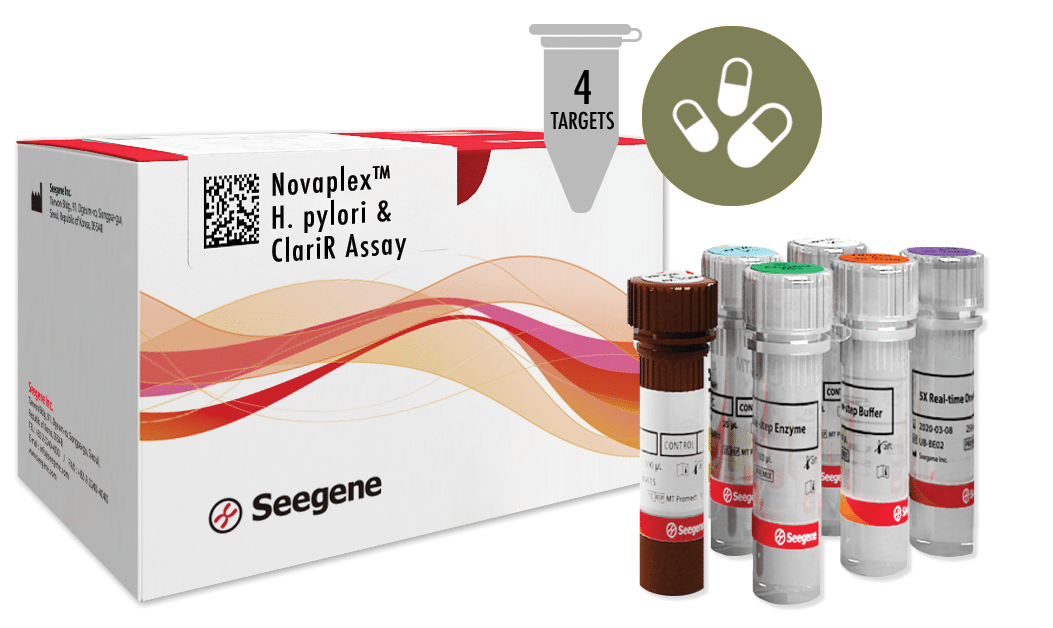
Helicobacter pylori (H. pylori) is a type of bacteria that infects the stomach and effects up to 40% of people in the United States. H. pylori infection is the most common cause of peptic ulcers and is commonly correlated with stomach cancers.1
-
Analytes
Novaplex™ Helicobacter pylori
Select the assays you are interested in and a Seegene representative will contact you to complete your order.- H. pylori
- A2142G
- A2143G
- A2142C
- Gastric biopsy specimen*
- Stool
*Automated PCR setup is recommended
Automated Extraction & PCR Setup
Seegene NIMBUS
Seegene STARlet
Real-time PCR
CFX96™ Real-time PCR System (Bio-Rad)
CFX96 Dx Real-Time PCR Detection System (Bio-Rad)
CFX96™ Opus (Bio-Rad)
CFX96™ Touch™ Real-Time PCR Detection System (Bio-Rad)
Seegene Viewer Software
- Quick and easy data analysis and interpretation
- Interface specialized for multiplex testing
- Multiplex real-time PCR: Simultaneous detection and identification of H. pylori and major mutations (A2142G, A2143G, A2142C) responsible for clarithromycin resistance
- Short TAT: 4 hours from extraction to final result
- Multi-Ct in a single channel: Individual Ct value of multiple analytes in a single channel of real-time PCR instrument (MuDT™ Technology)
- Cost-effective testing: Allows for the detection of H. pylori infection and clarithromycin resistance in a single test
H. pylori is the main cause of gastroduodenal diseases and is a common bacterial infection with more than 1.2 million annual new infections in the US alone. Most of the infected population are carriers and may not develop clinical complications from the infection but those that develop gastroduodenal diseases may suffer from peptic ulcers, gastric cancer, and mucosa-associated lymphoid tissue lymphomas (MALT). The increase in H. pylori prevalence is suspected to be correlated to the growing resistance of H. pylori to antibiotics.
Detection utilizing traditional methods tends to be time consuming, requires significant hands-on time and can be inaccurate due to an inability to test for more than a single strain, all of which makes this bacterium challenging to detect.
The use of multiplex real-time PCR-based technology allows for the simultaneous detection of multiple strains of H. pylori, increasing sensitivity and reducing turnaround time with fewer lab inefficiencies. This technology can specifically target more drug virulence or antibiotic resistance genes in a single test.
Novaplex™ H. pylori & ClariR Assay is a multiplex real-time PCR assay that detects and identifies H. pylori and the most frequent point mutations (A2142G, A2143G and A2142C) responsible for clarithromycin resistance within the H. pylori 23S rRNA gene. The kit utilizes stool or gastric biopsy specimens. With Novaplex H. pylori & ClariR Assays, users can conveniently detect H. pylori DNA in stool and perform PCR in a non-invasive way without the need for endoscopy.
*Novaplex™ Assays are For Research Use Only. Not for Use in Diagnostic Procedures.
1 https://www.ucsfhealth.org/medical-tests/helicobacter-pylori-infection

